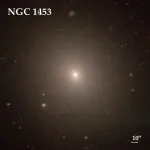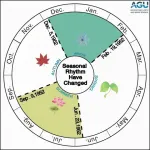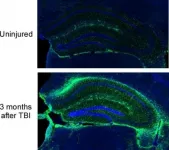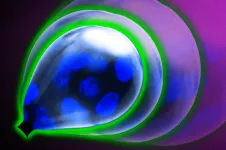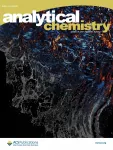A new estimate of the local expansion rate -- the Hubble constant, or H0 (H-naught) -- reinforces that discrepancy.
Using a relatively new and potentially more precise technique for measuring cosmic distances, which employs the average stellar brightness within giant elliptical galaxies as a rung on the distance ladder, astronomers calculate a rate -- 73.3 kilometers per second per megaparsec, give or take 2.5 km/sec/Mpc -- that lies in the middle of three other good estimates, including the gold standard estimate from Type Ia supernovae. This means that for every megaparsec -- 3.3 million light years, or 3 billion trillion kilometers -- from Earth, the universe is expanding an extra 73.3 ±2.5 kilometers per second. The average from the three other techniques is 73.5 ±1.4 km/sec/Mpc.
Perplexingly, estimates of the local expansion rate based on measured fluctuations in the cosmic microwave background and, independently, fluctuations in the density of normal matter in the early universe (baryon acoustic oscillations), give a very different answer: 67.4 ±0.5 km/sec/Mpc.
Astronomers are understandably concerned about this mismatch, because the expansion rate is a critical parameter in understanding the physics and evolution of the universe and is key to understanding dark energy -- which accelerates the rate of expansion of the universe and thus causes the Hubble constant to change more rapidly than expected with increasing distance from Earth. Dark energy comprises about two-thirds of the mass and energy in the universe, but is still a mystery.
For the new estimate, astronomers measured fluctuations in the surface brightness of 63 giant elliptical galaxies to determine the distance and plotted distance against velocity for each to obtain H0. The surface brightness fluctuation (SBF) technique is independent of other techniques and has the potential to provide more precise distance estimates than other methods within about 100 Mpc of Earth, or 330 million light years. The 63 galaxies in the sample are at distances ranging from 15 to 99 Mpc, looking back in time a mere fraction of the age of the universe.
"For measuring distances to galaxies out to 100 megaparsecs, this is a fantastic method," said cosmologist Chung-Pei Ma, the Judy Chandler Webb Professor in the Physical Sciences at the University of California, Berkeley, and professor of astronomy and physics. "This is the first paper that assembles a large, homogeneous set of data, on 63 galaxies, for the goal of studying H-naught using the SBF method."
Ma leads the MASSIVE survey of local galaxies, which provided data for 43 of the galaxies -- two-thirds of those employed in the new analysis.
The data on these 63 galaxies was assembled and analyzed by John Blakeslee, an astronomer with the National Science Foundation's NOIRLab. He is first author of a paper now accepted for publication in The Astrophysical Journal that he co-authored with colleague Joseph Jensen of Utah Valley University in Orem. Blakeslee, who heads the science staff that support NSF's optical and infrared observatories, is a pioneer in using SBF to measure distances to galaxies, and Jensen was one of the first to apply the method at infrared wavelengths. The two worked closely with Ma on the analysis.
"The whole story of astronomy is, in a sense, the effort to understand the absolute scale of the universe, which then tells us about the physics," Blakeslee said, harkening back to James Cook's voyage to Tahiti in 1769 to measure a transit of Venus so that scientists could calculate the true size of the solar system. "The SBF method is more broadly applicable to the general population of evolved galaxies in the local universe, and certainly if we get enough galaxies with the James Webb Space Telescope, this method has the potential to give the best local measurement of the Hubble constant."
The James Webb Space Telescope, 100 times more powerful than the Hubble Space Telescope, is scheduled for launch in October.
Giant elliptical galaxies
The Hubble constant has been a bone of contention for decades, ever since Edwin Hubble first measured the local expansion rate and came up with an answer seven times too big, implying that the universe was actually younger than its oldest stars. The problem, then and now, lies in pinning down the location of objects in space that give few clues about how far away they are.
Astronomers over the years have laddered up to greater distances, starting with calculating the distance to objects close enough that they seem to move slightly, because of parallax, as the Earth orbits the sun. Variable stars called Cepheids get you farther, because their brightness is linked to their period of variability, and Type Ia supernovae get you even farther, because they are extremely powerful explosions that, at their peak, shine as bright as a whole galaxy. For both Cepheids and Type Ia supernovae, it's possible to figure out the absolute brightness from the way they change over time, and then the distance can be calculated from their apparent brightness as seen from Earth.
The best current estimate of H0 comes from distances determined by Type Ia supernova explosions in distant galaxies, though newer methods -- time delays caused by gravitational lensing of distant quasars and the brightness of water masers orbiting black holes -- all give around the same number.
The technique using surface brightness fluctuations is one of the newest and relies on the fact that giant elliptical galaxies are old and have a consistent population of old stars -- mostly red giant stars -- that can be modeled to give an average infrared brightness across their surface. The researchers obtained high-resolution infrared images of each galaxy with the Wide Field Camera 3 on the Hubble Space Telescope and determined how much each pixel in the image differed from the "average" -- the smoother the fluctuations over the entire image, the farther the galaxy, once corrections are made for blemishes like bright star-forming regions, which the authors exclude from the analysis.
Neither Blakeslee nor Ma was surprised that the expansion rate came out close to that of the other local measurements. But they are equally confounded by the glaring conflict with estimates from the early universe -- a conflict that many astronomers say means that our current cosmological theories are wrong, or at least incomplete.
The extrapolations from the early universe are based on the simplest cosmological theory -- called lambda cold dark matter, or ΛCDM -- which employs just a few parameters to describe the evolution of the universe. Does the new estimate drive a stake into the heart of ΛCDM?
"I think it pushes that stake in a bit more," Blakeslee said. "But it (ΛCDM) is still alive. Some people think, regarding all these local measurements, (that) the observers are wrong. But it is getting harder and harder to make that claim -- it would require there to be systematic errors in the same direction for several different methods: supernovae, SBF, gravitational lensing, water masers. So, as we get more independent measurements, that stake goes a little deeper."
Ma wonders whether the uncertainties astronomers ascribe to their measurements, which reflect both systematic errors and statistical errors, are too optimistic, and that perhaps the two ranges of estimates can still be reconciled.
"The jury is out," she said. "I think it really is in the error bars. But assuming everyone's error bars are not underestimated, the tension is getting uncomfortable."
In fact, one of the giants of the field, astronomer Wendy Freedman, recently published a study pegging the Hubble constant at 69.8 ±1.9 km/sec/Mpc, roiling the waters even further. The latest result from Adam Riess, an astronomer who shared the 2011 Nobel Prize in Physics for discovering dark energy, reports 73.2 ±1.3 km/sec/Mpc. Riess was a Miller Postdoctoral Fellow at UC Berkeley when he performed this research, and he shared the prize with UC Berkeley and Berkeley Lab physicist Saul Perlmutter.
MASSIVE galaxies
The new value of H0 is a byproduct of two other surveys of nearby galaxies -- in particular, Ma's MASSIVE survey, which uses space and ground-based telescopes to exhaustively study the 100 most massive galaxies within about 100 Mpc of Earth. A major goal is to weigh the supermassive black holes at the centers of each one.
To do that, precise distances are needed, and the SBF method is the best to date, she said. The MASSIVE survey team used this method last year to determine the distance to a giant elliptical galaxy, NGC 1453, in the southern sky constellation of Eridanus. Combining that distance, 166 million light years, with extensive spectroscopic data from the Gemini and McDonald telescopes -- which allowed Ma's graduate students Chris Liepold and Matthew Quenneville to measure the velocities of the stars near the center of the galaxy -- they concluded that NGC 1453 has a central black hole with a mass nearly 3 billion times that of the sun.
To determine H0, Blakeslee calculated SBF distances to 43 of the galaxies in the MASSIVE survey, based on 45 to 90 minutes of HST observing time for each galaxy. The other 20 came from another survey that employed HST to image large galaxies, specifically ones in which Type Ia supernovae have been detected.
Most of the 63 galaxies are between 8 and 12 billion years old, which means that they contain a large population of old red stars, which are key to the SBF method and can also be used to improve the precision of distance calculations. In the paper, Blakeslee employed both Cepheid variable stars and a technique that uses the brightest red giant stars in a galaxy -- referred to as the tip of the red giant branch, or TRGB technique -- to ladder up to galaxies at large distances. They produced consistent results. The TRGB technique takes account of the fact that the brightest red giants in galaxies have about the same absolute brightness.
"The goal is to make this SBF method completely independent of the Cepheid-calibrated Type Ia supernova method by using the James Webb Space Telescope to get a red giant branch calibration for SBFs," he said.
"The James Webb telescope has the potential to really decrease the error bars for SBF," Ma added. But for now, the two discordant measures of the Hubble constant will have to learn to live with one another.
"I was not setting out to measure H0; it was a great product of our survey," she said. "But I am a cosmologist and am watching this with great interest."
INFORMATION:
Co-authors of the paper with Blakeslee, Ma and Jensen are Jenny Greene of Princeton University, who is a leader of the MASSIVE team, and Peter Milne of the University of Arizona in Tucson, who leads the team studying Type Ia supernovae. The work was supported by the National Aeronautics and Space Administration (HST-GO-14219, HST-GO-14654, HST GO-15265) and the National Science Foundation (AST-1815417, AST-1817100).
